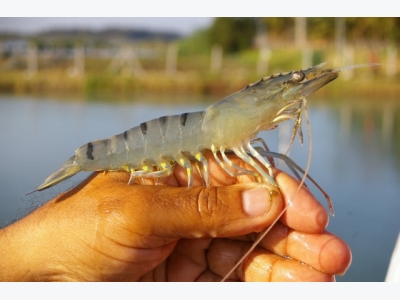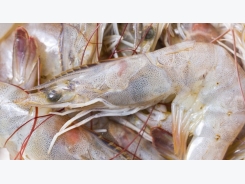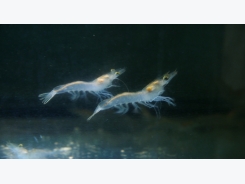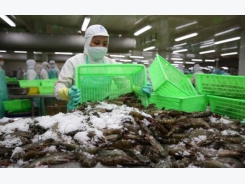Bacterial diseases of shrimps and their management

Vibriosis and related bacterial diseases
- Vibrio spp. –
- form major cultivable bacteria isolated from diseased penaeid shrimp
- opportunistic pathogens
- some behave like true pathogens
- Main species : V. alginolyticus, V. parahaemolyticus
- V. harveyi, V. splendidus, V. vulnificus and V. damsela.
- Other gram-negative rods
- Flavobacterium spp. Pseudomonas spp and Aeromonas spp
Bacterial infections in shrimp from
- 1) localized pits in the cuticle, which constitute the condition called bacterial shell disease
- 2) localized infections of the gut or hepatopancreas or localised infections from puncture wounds, limp loss etc. and
- 3) Generalised septicaemia. All life stages of the penaeid shrimp may be affected.
Luminescent bacterial infection
- reported from hatcheries different countries.
Gross Signs:
- Larvae become weak and opaque - exhibit luminescence
- Internal tissues of the larvae get densely packed with highly motile bacteria.
- Systemic infection results in larvae and postlarvae - mortalities reach up to 100%
- Larvae become anorexic. SEM indicate colonisation of vibrios on the feeding appendages and oral cavity.
- Causative agents: Vibrio parahaemolyticus, V.alginolyticus V.harveyi and V.splendidus.
Control of disease Sanitation and rigorous management practices.
- Separation of female shrimps and their faecal matter from the eggs as soon as possible after spawning.
- Rinse artemia nauplii before introducing into the hatchery
- Chlorinate the hatchery water sufficiently
- Treat the water with ultraviolet irradiation and filtration.
- Thorough cleaning, disinfection using 200 ppm chlorinated water and drying of the larval rearing tanks after each cycle of operation helps to control bacterial load and eliminate bacterial pathogens.
Add antibacterial to larval rearing tanks in case of hatchery vibriosis.
- Antibiotics are given as medicated live feeds to mysis and PL, or administered in medicated feeds to late – mysis, PL, juveniles and adults.
- Chloramphenicol, sodium nifurstyrenate, and the nitrofurans (furazolidone, nitrofurazone, nitrofu-rantoin and prefuran) have shown relatively low minimum inhibitory and bactericidal concentration
- Strict water quality management and sanitation are highly recommended for preventing luminous vibriosis in penaeid hatcheries.
Vibriosis in culture ponds
- Major symptoms were cloudiness in hepatopancreas in PL, cloudiness of muscles in sixth abdominal segment, and progressive spots on gills and lymphoid organ.
- Histopathology - extensive necrosis and bacterial invasion of lymphoid organ, with multiple melanized hemocytic nodules. Nodules were found in all the organs while inflammation was found only in lymphoid organ.
- The symptoms observed are lethargic swimming of shrimps at the end of the growout period. Survival was 5-30% with stunted growth of the individuals.
- Affected shrimps lost their escape reflexes, had darkened colour and heavy fouling by epibionts. Less affected were pale and opaque, and gills were brown in colour.
- Body reddening, extended gill covers, slight melanized erosion of uropods, pleopods and periopods.
- empty stomach and midgut except for a watery white liquid. Small black spots on the lymphoid organ.
- V.alginolyticus V.parahaemolyticus and Pseudomonas species were obtained from the hemolymph.
- Vibriosis occurred during 1989 and in Ecuador which was called Sindroma Gaviota (or Sea Gull Syndrome, SGS) where large number of sea birds were observed to gather on or near ponds and to feed on dead and dying shrimps. Hence it was called as seagull syndrome.
- Gross signs were similar to vibriosis.
Factors affecting SGS vibriosis
- Salinity and nutrient content of the water
- High salinity favours the growth of Vibrio in general. Higher quantities of organic and inorganic fertilizers also contributed to the bloom of Vibrio spp.
- Control of Vibriosis in culture ponds
- Reduction of biomass by partial harvest or reducing stocking density and increasing the water exchange
- For subsequent production cycles, dry the pond bottom soil cracks.
- Excessive detritus have to be removed physically by desilting the pond bottom. Quick lime has to be applied at the rate of 0.5 kg/m2 of pond bottom.
Antibacterial agents used to control vibriosis
- Oxytetracycline (OTC) medicated feeds were reported to be effective in controlling vibriosis
- Administration of 5 or 100 mg/kg of body weight of shrimp per day of OCT in a special feed for 4 to 6 days was found effective.
Bacterial shell disease
- Clinical signs and symptoms
- Lesions - brownish to black in colour.
- Single or multiple erroded areas on the general body cuticle, appendages, or gills
- Lesions begin as small local lesions (due to abrasions, puncture wounds, chemical trauma or other causes) that rapidly enlarge.
- This disease is also called as brown spot shell disease / burned spot disease / rust disease / shell disease or blackspot disease.
- Causative agent
- Vibrio, Pseudomonas or Beneckea
- cause erosions and ulcerations of the cuticle by lipases, proteases, and chitinases.
- black pigment in the lesions is melanin - end product of the crustacean inflammatory response.
- If not resolved by the shrimp defence, septicaemia and death will result.
Diagnosis
- Based on gross symptoms and isolation of the bacteria from the site of infection and identification of the pathogen.
Control measures
- Provision of better water quality, removal of infected and dead prawns, reducing the stock and adequate nutrition
- Reduce the organic load in the pond by increased water exchange.
- Feed terramycin incorporated feed at 0.45 mg/kg of feed for two weeks, bath treatment using 0.05 to 1.0 mg of malachite green per litre of water are suggested
Brown or Black Spot disease (shell disease, rust disease, burned spot disease, necrosis, etc.)
- Causative agents: Vibrio , Aeromonas and Pseudomonas.
- Affected stages are larvae, post larvae and even juveniles and adults.
- Appearance of brownish to black erosion of the carapace, abdominal segments rostrum, tail, gills and appendages.
- Affected part shows a cigarette butt like appearance.
- Infection starts at sites of injuries or from other damage caused by cannibalism.
- Lesions progress upon entry and multiplication of bacterial pathogens.
Prevention
- Maintain good water quality and reduce organic load by removing sediments, dead shrimps and moulted exoskeletons which harbour high numbers of bacteria on the lesions.
- Minimise handling and avoid over crowding.
Treatment
- Treatment with formalin 25 ppm in static condition for 24 hrs is recommended.
Filamentous bacterial infection
- Larvae, postlarvae, juveniles and adults affected.
- Clinical Signs: presence of fine, colourless, thread- like growth on the body surface and gills.
- Interfere with locomotary process and moulting - cause mortalities of PL with heavy infestations. In larger shrimps it result in respiratory distress.
- Bacteria involved: Leucothrix species.
- Other types of filamentous bacteria such as Thiothrix, Flexibacter, Cytophaga, and possibly Flavobacterium, alone or together with Leucothrix are also important agents of filamentous bacterial disease.
Treatment
- KMNO4 at 5-10 pm for 1hr in static treatment for 5-10 days.
Rickettsial and Chlamydial diseases
- Reported from different geographic locations.
- Chlamydia in penaeid shrimp – like agent observed in the cytoplasm of hepatopancreatic cells of P. japonicus which were infected by BMN.
- Rickettsial infections has rickettsial inclusions in cytoplasmic masses of infected hepatopancreas cells
- Reduced feed consumption and moderate mortalities .
- lethargy, anorexia, poor escape responses and a white colored hepatopancreas.
- Texas pond mortality syndrome (TPMS) reported from Texas due to Rickettsia – like agent in P.vannamei - upto 50% to 99% stock were affected.
Control
- Medicated feeds containing 1.5 to 2.0 kg of Oxytetracycline / 1000kg of feed. OTC at 1.5g of active drug per kg feed).
- Because of their small size and inculturability by microbiological methods, the rickettsia, chalmydia and related small bacterial forms may be frequently over looked.
Mycobacterial infections
- Causative agent : Mycobacterium marinum.
- Symptoms: abnormally dark pigmentation in areas of the body that hard multicolour melanized hemocytic nodules or larger prominent melanized granulomatous lesions composed of multiple nodules occur.
- Lesions observed in the lymphoid organ, heart, cuticle and systemically in the loose connective tissue of muscle, hepatopancreas, antennal gland, ovary and gills.
- No control measures
Recent innovations in containing vibriosis
- Immunostimulants: Use of immunostimulants fed through the feed is found to provide better resistance to diseases by stimulating the non-specific defence mechanisms of shrimps.
- Common immunostimulants used in shrimp farming are glucans, synthetic drug levamisole, animal derived products viz. chitin and abalone extract and plant derived alginates.
Probiotics
- Use of probiotic bacteria is found to compete with Vibrio species there by decreasing the load of pathogenic organisms.
- In shrimp farms this aids in various environmental activities like breaking down of organic matter, unutilised feed and faecal matter including water quality maintenance.
- There are different commercial preparations of bacteria like Lactobacillus species used as probiotics. Bacillus spp. ,Nitrosomonas sp.,Nitrobacter, Pseudomonas etc. form as components in various probiotic preparations.
- Of all the methods tried for prevention and control, strict management measures is found to be best either in hatcheries or on growout ponds in the case of vibriosis since Vibrio spp. are mainly opportunistic pathogens.
Control and preventive measures for bacterial diseases
- Treatment with chemicals or antibiotics would stress the animals and there are chances of antibiotic resistant bacteria developing. The following measures are useful in preventing the diseases.
Provision of pollutant free water
- Provision of treated water
- Scientific pond preparation
- Selection of healthy larvae for stocking optimum density
- Routine water quality maintenance
- Proper feeding
- Regular observation of shrimps
Prevent contamination of farm implements
- In case of disease outbreak disinfect before letting out the water
- Avoid entry of birds and other wild animals
- Provision of crop holydays
- Adopting crop rotation
Related news
Tools

Phối trộn thức ăn chăn nuôi

Pha dung dịch thủy canh

Định mức cho tôm ăn

Phối trộn phân bón NPK

Xác định tỷ lệ tôm sống

Chuyển đổi đơn vị phân bón

Xác định công suất sục khí

Chuyển đổi đơn vị tôm

Tính diện tích nhà kính

Tính thể tích ao




 New bio-processed protein concentrate shows potential
New bio-processed protein concentrate shows potential  Shrimping horizons: how farmers are saving thousands of…
Shrimping horizons: how farmers are saving thousands of…